Money Laundering in Malaysia's Financial Institutions: A Review
VerifiedAdded on 2021/04/24
|34
|10583
|38
Report
AI Summary
This report provides a comprehensive literature review on money laundering within Malaysia's financial institutions. It begins with an overview of Malaysia and its banking industry, highlighting the sector's growth and importance while acknowledging the underlying issues of corporate fraud, money laundering, and corruption. The report delves into the concept and history of money laundering, tracing its origins and evolution. It discusses the role of forensic accounting skills in detecting and preventing money laundering, particularly from the perspective of AML experts. The report also examines the regulatory framework, including the AMLATFPUA 2001 and its amendments, which are crucial for combating money laundering and terrorism financing. It addresses the challenges faced by banks in detecting and preventing money laundering, emphasizing the need for robust risk assessment mechanisms, IT infrastructure, and compliance departments. The report concludes by underscoring the ongoing risks of money laundering in the Malaysian banking sector and the continuous efforts required to combat these threats.
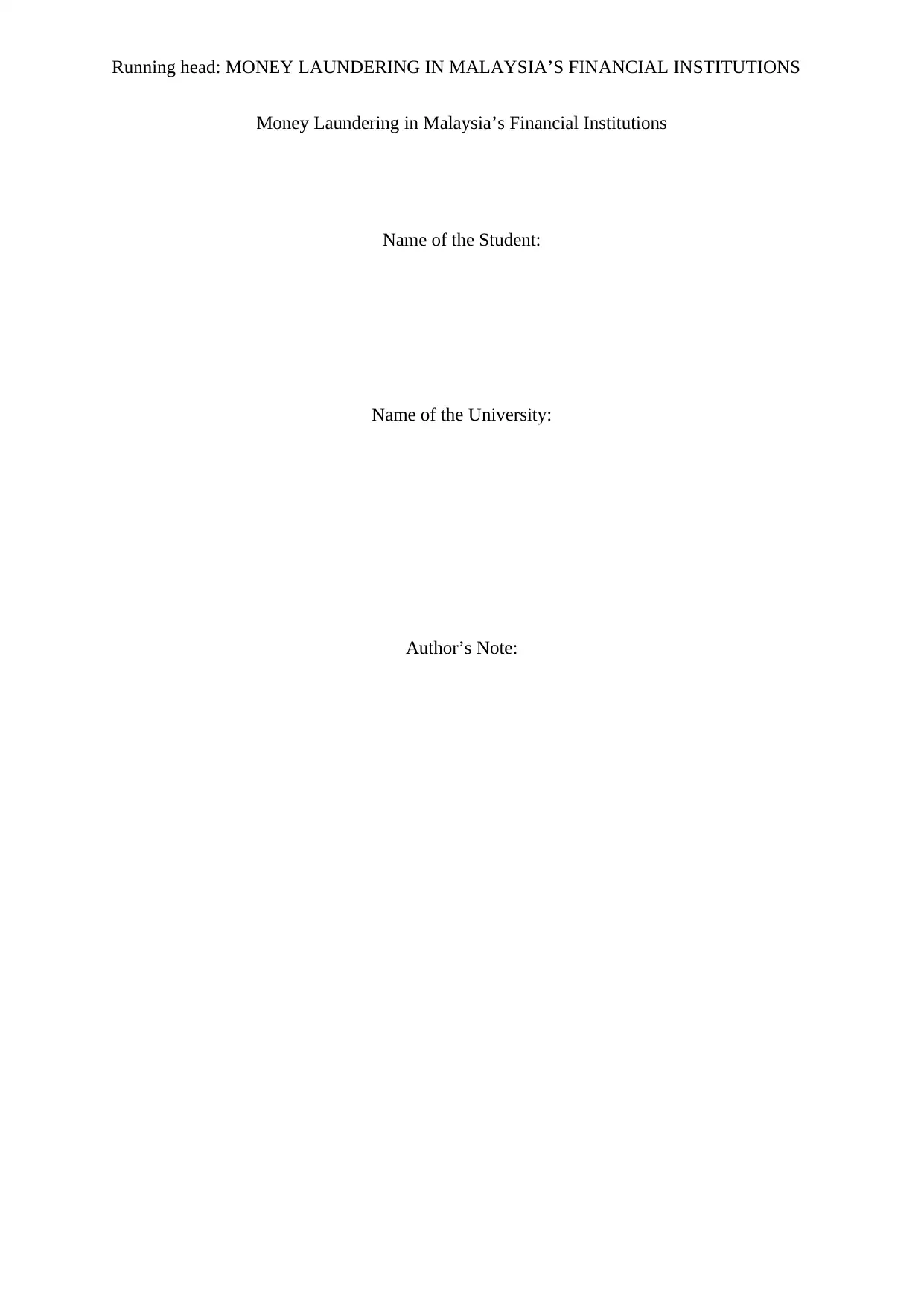
Running head: MONEY LAUNDERING IN MALAYSIA’S FINANCIAL INSTITUTIONS
Money Laundering in Malaysia’s Financial Institutions
Name of the Student:
Name of the University:
Author’s Note:
Money Laundering in Malaysia’s Financial Institutions
Name of the Student:
Name of the University:
Author’s Note:
Paraphrase This Document
Need a fresh take? Get an instant paraphrase of this document with our AI Paraphraser
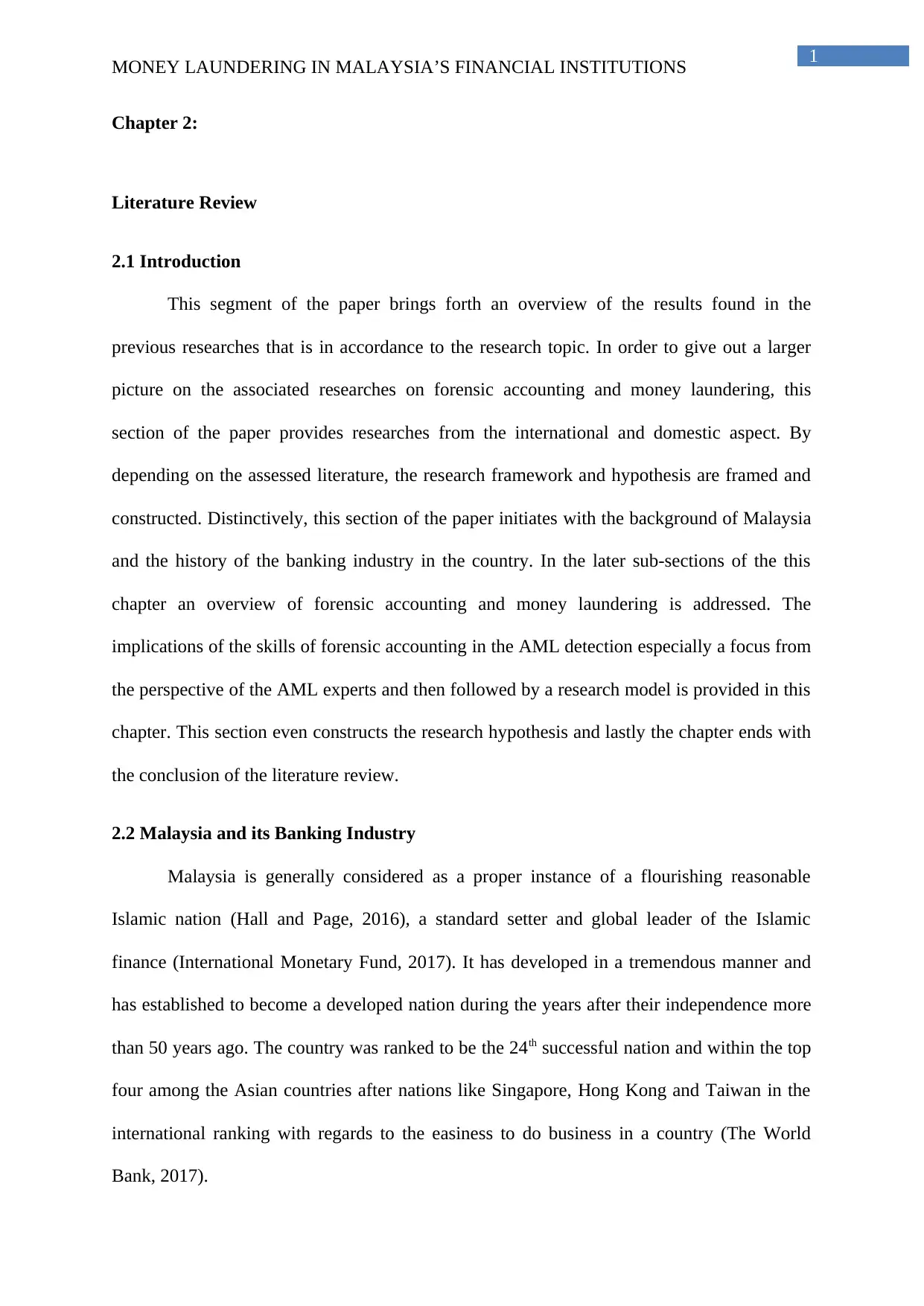
1
MONEY LAUNDERING IN MALAYSIA’S FINANCIAL INSTITUTIONS
Chapter 2:
Literature Review
2.1 Introduction
This segment of the paper brings forth an overview of the results found in the
previous researches that is in accordance to the research topic. In order to give out a larger
picture on the associated researches on forensic accounting and money laundering, this
section of the paper provides researches from the international and domestic aspect. By
depending on the assessed literature, the research framework and hypothesis are framed and
constructed. Distinctively, this section of the paper initiates with the background of Malaysia
and the history of the banking industry in the country. In the later sub-sections of the this
chapter an overview of forensic accounting and money laundering is addressed. The
implications of the skills of forensic accounting in the AML detection especially a focus from
the perspective of the AML experts and then followed by a research model is provided in this
chapter. This section even constructs the research hypothesis and lastly the chapter ends with
the conclusion of the literature review.
2.2 Malaysia and its Banking Industry
Malaysia is generally considered as a proper instance of a flourishing reasonable
Islamic nation (Hall and Page, 2016), a standard setter and global leader of the Islamic
finance (International Monetary Fund, 2017). It has developed in a tremendous manner and
has established to become a developed nation during the years after their independence more
than 50 years ago. The country was ranked to be the 24th successful nation and within the top
four among the Asian countries after nations like Singapore, Hong Kong and Taiwan in the
international ranking with regards to the easiness to do business in a country (The World
Bank, 2017).
MONEY LAUNDERING IN MALAYSIA’S FINANCIAL INSTITUTIONS
Chapter 2:
Literature Review
2.1 Introduction
This segment of the paper brings forth an overview of the results found in the
previous researches that is in accordance to the research topic. In order to give out a larger
picture on the associated researches on forensic accounting and money laundering, this
section of the paper provides researches from the international and domestic aspect. By
depending on the assessed literature, the research framework and hypothesis are framed and
constructed. Distinctively, this section of the paper initiates with the background of Malaysia
and the history of the banking industry in the country. In the later sub-sections of the this
chapter an overview of forensic accounting and money laundering is addressed. The
implications of the skills of forensic accounting in the AML detection especially a focus from
the perspective of the AML experts and then followed by a research model is provided in this
chapter. This section even constructs the research hypothesis and lastly the chapter ends with
the conclusion of the literature review.
2.2 Malaysia and its Banking Industry
Malaysia is generally considered as a proper instance of a flourishing reasonable
Islamic nation (Hall and Page, 2016), a standard setter and global leader of the Islamic
finance (International Monetary Fund, 2017). It has developed in a tremendous manner and
has established to become a developed nation during the years after their independence more
than 50 years ago. The country was ranked to be the 24th successful nation and within the top
four among the Asian countries after nations like Singapore, Hong Kong and Taiwan in the
international ranking with regards to the easiness to do business in a country (The World
Bank, 2017).
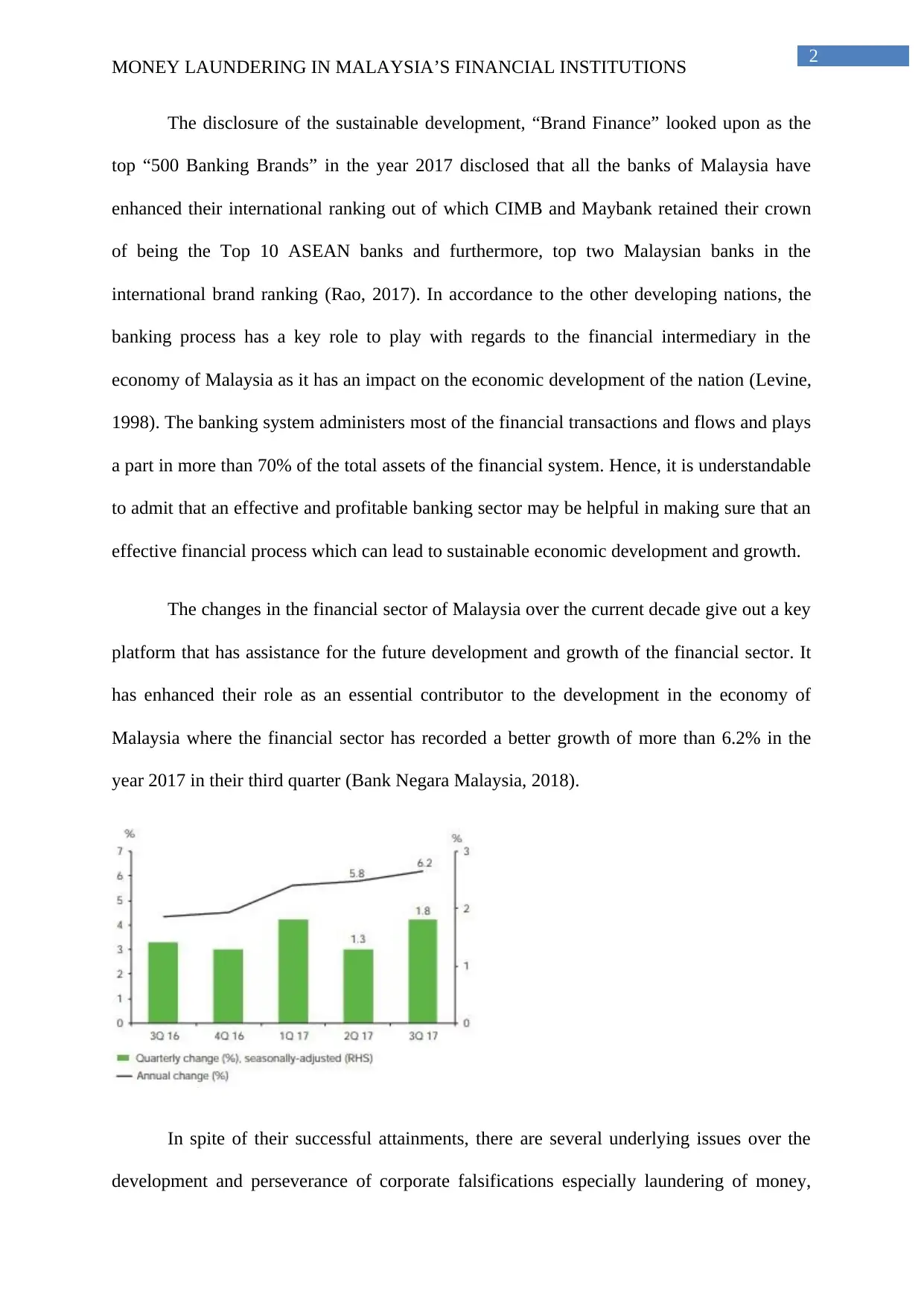
2
MONEY LAUNDERING IN MALAYSIA’S FINANCIAL INSTITUTIONS
The disclosure of the sustainable development, “Brand Finance” looked upon as the
top “500 Banking Brands” in the year 2017 disclosed that all the banks of Malaysia have
enhanced their international ranking out of which CIMB and Maybank retained their crown
of being the Top 10 ASEAN banks and furthermore, top two Malaysian banks in the
international brand ranking (Rao, 2017). In accordance to the other developing nations, the
banking process has a key role to play with regards to the financial intermediary in the
economy of Malaysia as it has an impact on the economic development of the nation (Levine,
1998). The banking system administers most of the financial transactions and flows and plays
a part in more than 70% of the total assets of the financial system. Hence, it is understandable
to admit that an effective and profitable banking sector may be helpful in making sure that an
effective financial process which can lead to sustainable economic development and growth.
The changes in the financial sector of Malaysia over the current decade give out a key
platform that has assistance for the future development and growth of the financial sector. It
has enhanced their role as an essential contributor to the development in the economy of
Malaysia where the financial sector has recorded a better growth of more than 6.2% in the
year 2017 in their third quarter (Bank Negara Malaysia, 2018).
In spite of their successful attainments, there are several underlying issues over the
development and perseverance of corporate falsifications especially laundering of money,
MONEY LAUNDERING IN MALAYSIA’S FINANCIAL INSTITUTIONS
The disclosure of the sustainable development, “Brand Finance” looked upon as the
top “500 Banking Brands” in the year 2017 disclosed that all the banks of Malaysia have
enhanced their international ranking out of which CIMB and Maybank retained their crown
of being the Top 10 ASEAN banks and furthermore, top two Malaysian banks in the
international brand ranking (Rao, 2017). In accordance to the other developing nations, the
banking process has a key role to play with regards to the financial intermediary in the
economy of Malaysia as it has an impact on the economic development of the nation (Levine,
1998). The banking system administers most of the financial transactions and flows and plays
a part in more than 70% of the total assets of the financial system. Hence, it is understandable
to admit that an effective and profitable banking sector may be helpful in making sure that an
effective financial process which can lead to sustainable economic development and growth.
The changes in the financial sector of Malaysia over the current decade give out a key
platform that has assistance for the future development and growth of the financial sector. It
has enhanced their role as an essential contributor to the development in the economy of
Malaysia where the financial sector has recorded a better growth of more than 6.2% in the
year 2017 in their third quarter (Bank Negara Malaysia, 2018).
In spite of their successful attainments, there are several underlying issues over the
development and perseverance of corporate falsifications especially laundering of money,
⊘ This is a preview!⊘
Do you want full access?
Subscribe today to unlock all pages.

Trusted by 1+ million students worldwide
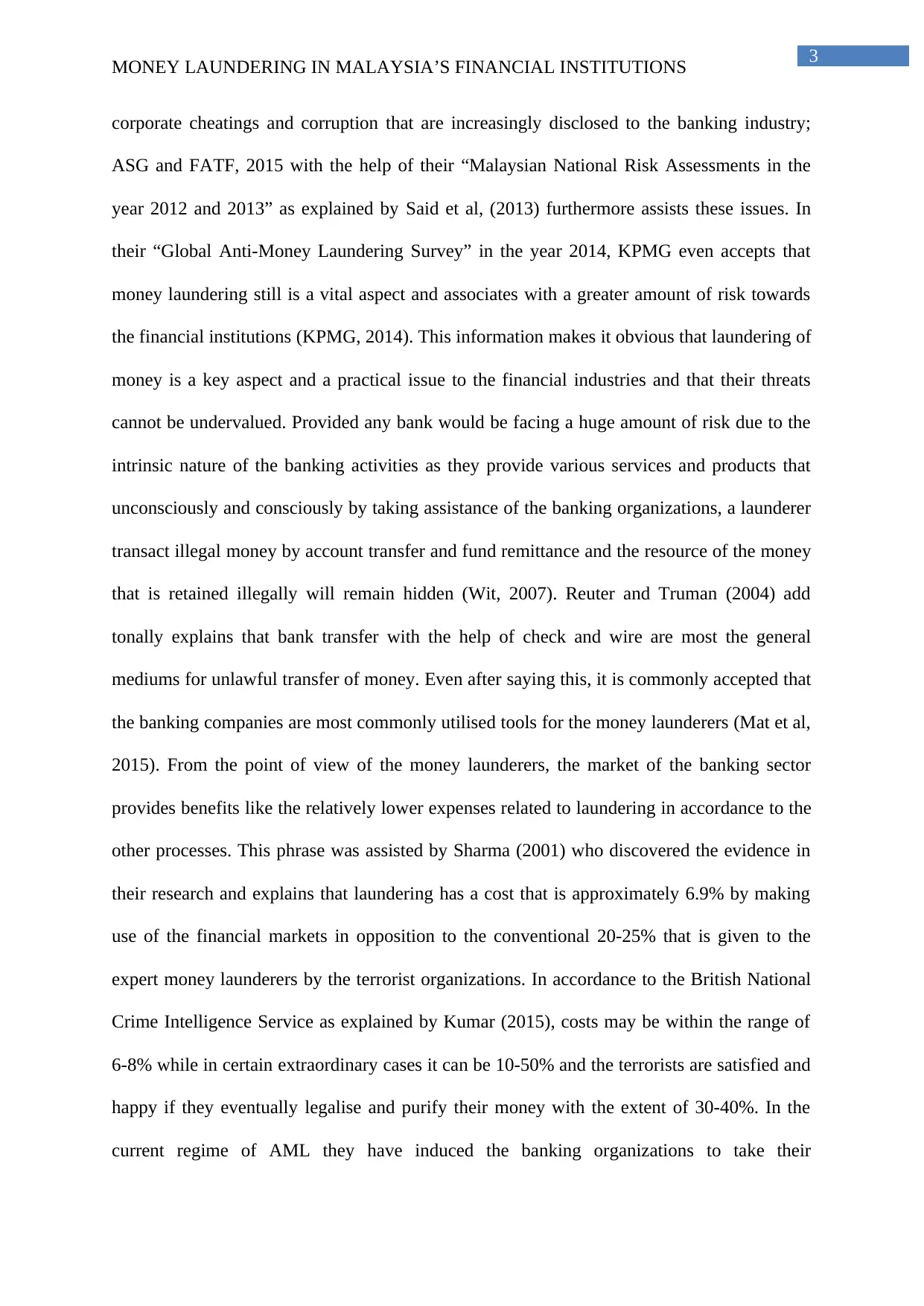
3
MONEY LAUNDERING IN MALAYSIA’S FINANCIAL INSTITUTIONS
corporate cheatings and corruption that are increasingly disclosed to the banking industry;
ASG and FATF, 2015 with the help of their “Malaysian National Risk Assessments in the
year 2012 and 2013” as explained by Said et al, (2013) furthermore assists these issues. In
their “Global Anti-Money Laundering Survey” in the year 2014, KPMG even accepts that
money laundering still is a vital aspect and associates with a greater amount of risk towards
the financial institutions (KPMG, 2014). This information makes it obvious that laundering of
money is a key aspect and a practical issue to the financial industries and that their threats
cannot be undervalued. Provided any bank would be facing a huge amount of risk due to the
intrinsic nature of the banking activities as they provide various services and products that
unconsciously and consciously by taking assistance of the banking organizations, a launderer
transact illegal money by account transfer and fund remittance and the resource of the money
that is retained illegally will remain hidden (Wit, 2007). Reuter and Truman (2004) add
tonally explains that bank transfer with the help of check and wire are most the general
mediums for unlawful transfer of money. Even after saying this, it is commonly accepted that
the banking companies are most commonly utilised tools for the money launderers (Mat et al,
2015). From the point of view of the money launderers, the market of the banking sector
provides benefits like the relatively lower expenses related to laundering in accordance to the
other processes. This phrase was assisted by Sharma (2001) who discovered the evidence in
their research and explains that laundering has a cost that is approximately 6.9% by making
use of the financial markets in opposition to the conventional 20-25% that is given to the
expert money launderers by the terrorist organizations. In accordance to the British National
Crime Intelligence Service as explained by Kumar (2015), costs may be within the range of
6-8% while in certain extraordinary cases it can be 10-50% and the terrorists are satisfied and
happy if they eventually legalise and purify their money with the extent of 30-40%. In the
current regime of AML they have induced the banking organizations to take their
MONEY LAUNDERING IN MALAYSIA’S FINANCIAL INSTITUTIONS
corporate cheatings and corruption that are increasingly disclosed to the banking industry;
ASG and FATF, 2015 with the help of their “Malaysian National Risk Assessments in the
year 2012 and 2013” as explained by Said et al, (2013) furthermore assists these issues. In
their “Global Anti-Money Laundering Survey” in the year 2014, KPMG even accepts that
money laundering still is a vital aspect and associates with a greater amount of risk towards
the financial institutions (KPMG, 2014). This information makes it obvious that laundering of
money is a key aspect and a practical issue to the financial industries and that their threats
cannot be undervalued. Provided any bank would be facing a huge amount of risk due to the
intrinsic nature of the banking activities as they provide various services and products that
unconsciously and consciously by taking assistance of the banking organizations, a launderer
transact illegal money by account transfer and fund remittance and the resource of the money
that is retained illegally will remain hidden (Wit, 2007). Reuter and Truman (2004) add
tonally explains that bank transfer with the help of check and wire are most the general
mediums for unlawful transfer of money. Even after saying this, it is commonly accepted that
the banking companies are most commonly utilised tools for the money launderers (Mat et al,
2015). From the point of view of the money launderers, the market of the banking sector
provides benefits like the relatively lower expenses related to laundering in accordance to the
other processes. This phrase was assisted by Sharma (2001) who discovered the evidence in
their research and explains that laundering has a cost that is approximately 6.9% by making
use of the financial markets in opposition to the conventional 20-25% that is given to the
expert money launderers by the terrorist organizations. In accordance to the British National
Crime Intelligence Service as explained by Kumar (2015), costs may be within the range of
6-8% while in certain extraordinary cases it can be 10-50% and the terrorists are satisfied and
happy if they eventually legalise and purify their money with the extent of 30-40%. In the
current regime of AML they have induced the banking organizations to take their
Paraphrase This Document
Need a fresh take? Get an instant paraphrase of this document with our AI Paraphraser
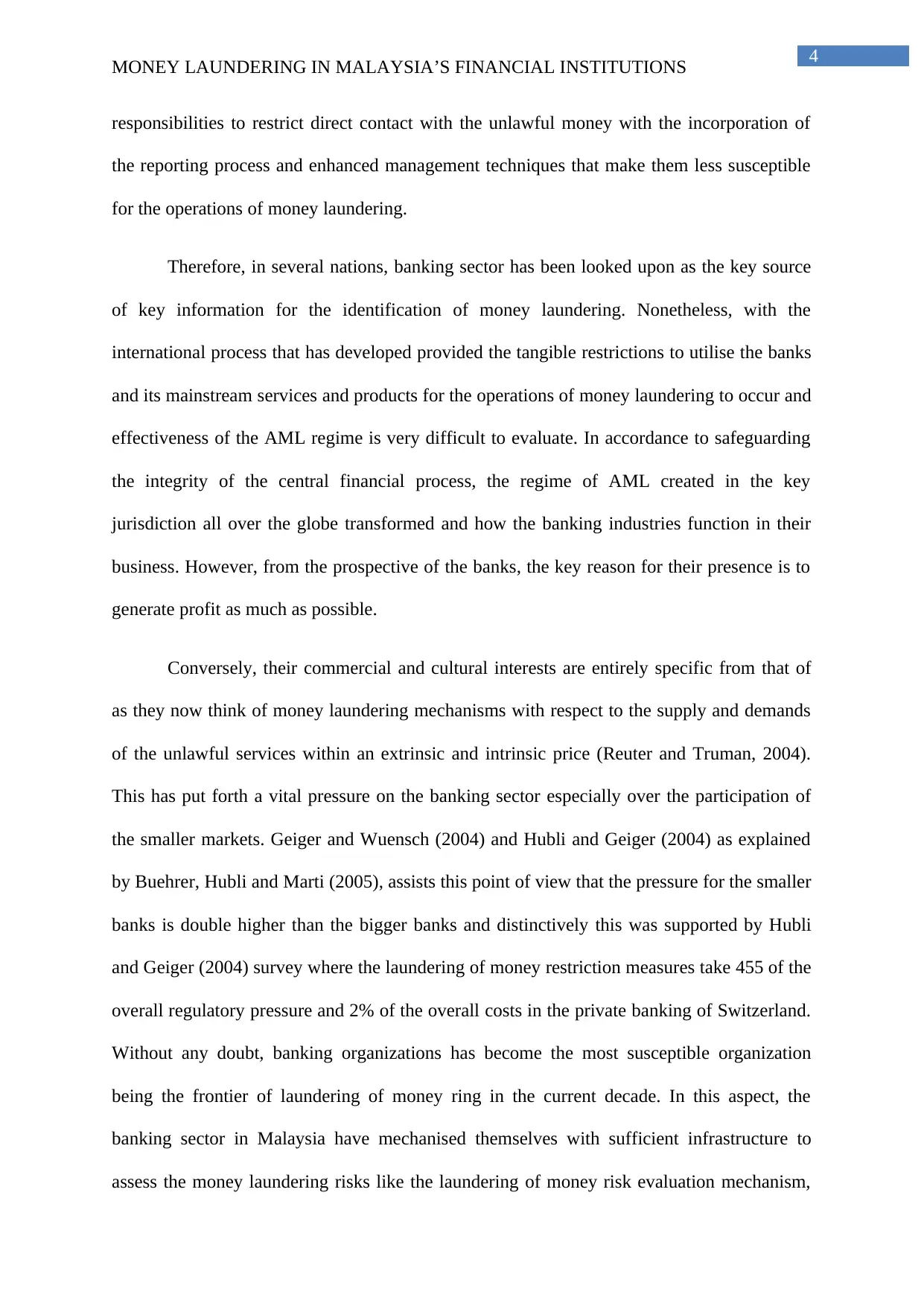
4
MONEY LAUNDERING IN MALAYSIA’S FINANCIAL INSTITUTIONS
responsibilities to restrict direct contact with the unlawful money with the incorporation of
the reporting process and enhanced management techniques that make them less susceptible
for the operations of money laundering.
Therefore, in several nations, banking sector has been looked upon as the key source
of key information for the identification of money laundering. Nonetheless, with the
international process that has developed provided the tangible restrictions to utilise the banks
and its mainstream services and products for the operations of money laundering to occur and
effectiveness of the AML regime is very difficult to evaluate. In accordance to safeguarding
the integrity of the central financial process, the regime of AML created in the key
jurisdiction all over the globe transformed and how the banking industries function in their
business. However, from the prospective of the banks, the key reason for their presence is to
generate profit as much as possible.
Conversely, their commercial and cultural interests are entirely specific from that of
as they now think of money laundering mechanisms with respect to the supply and demands
of the unlawful services within an extrinsic and intrinsic price (Reuter and Truman, 2004).
This has put forth a vital pressure on the banking sector especially over the participation of
the smaller markets. Geiger and Wuensch (2004) and Hubli and Geiger (2004) as explained
by Buehrer, Hubli and Marti (2005), assists this point of view that the pressure for the smaller
banks is double higher than the bigger banks and distinctively this was supported by Hubli
and Geiger (2004) survey where the laundering of money restriction measures take 455 of the
overall regulatory pressure and 2% of the overall costs in the private banking of Switzerland.
Without any doubt, banking organizations has become the most susceptible organization
being the frontier of laundering of money ring in the current decade. In this aspect, the
banking sector in Malaysia have mechanised themselves with sufficient infrastructure to
assess the money laundering risks like the laundering of money risk evaluation mechanism,
MONEY LAUNDERING IN MALAYSIA’S FINANCIAL INSTITUTIONS
responsibilities to restrict direct contact with the unlawful money with the incorporation of
the reporting process and enhanced management techniques that make them less susceptible
for the operations of money laundering.
Therefore, in several nations, banking sector has been looked upon as the key source
of key information for the identification of money laundering. Nonetheless, with the
international process that has developed provided the tangible restrictions to utilise the banks
and its mainstream services and products for the operations of money laundering to occur and
effectiveness of the AML regime is very difficult to evaluate. In accordance to safeguarding
the integrity of the central financial process, the regime of AML created in the key
jurisdiction all over the globe transformed and how the banking industries function in their
business. However, from the prospective of the banks, the key reason for their presence is to
generate profit as much as possible.
Conversely, their commercial and cultural interests are entirely specific from that of
as they now think of money laundering mechanisms with respect to the supply and demands
of the unlawful services within an extrinsic and intrinsic price (Reuter and Truman, 2004).
This has put forth a vital pressure on the banking sector especially over the participation of
the smaller markets. Geiger and Wuensch (2004) and Hubli and Geiger (2004) as explained
by Buehrer, Hubli and Marti (2005), assists this point of view that the pressure for the smaller
banks is double higher than the bigger banks and distinctively this was supported by Hubli
and Geiger (2004) survey where the laundering of money restriction measures take 455 of the
overall regulatory pressure and 2% of the overall costs in the private banking of Switzerland.
Without any doubt, banking organizations has become the most susceptible organization
being the frontier of laundering of money ring in the current decade. In this aspect, the
banking sector in Malaysia have mechanised themselves with sufficient infrastructure to
assess the money laundering risks like the laundering of money risk evaluation mechanism,
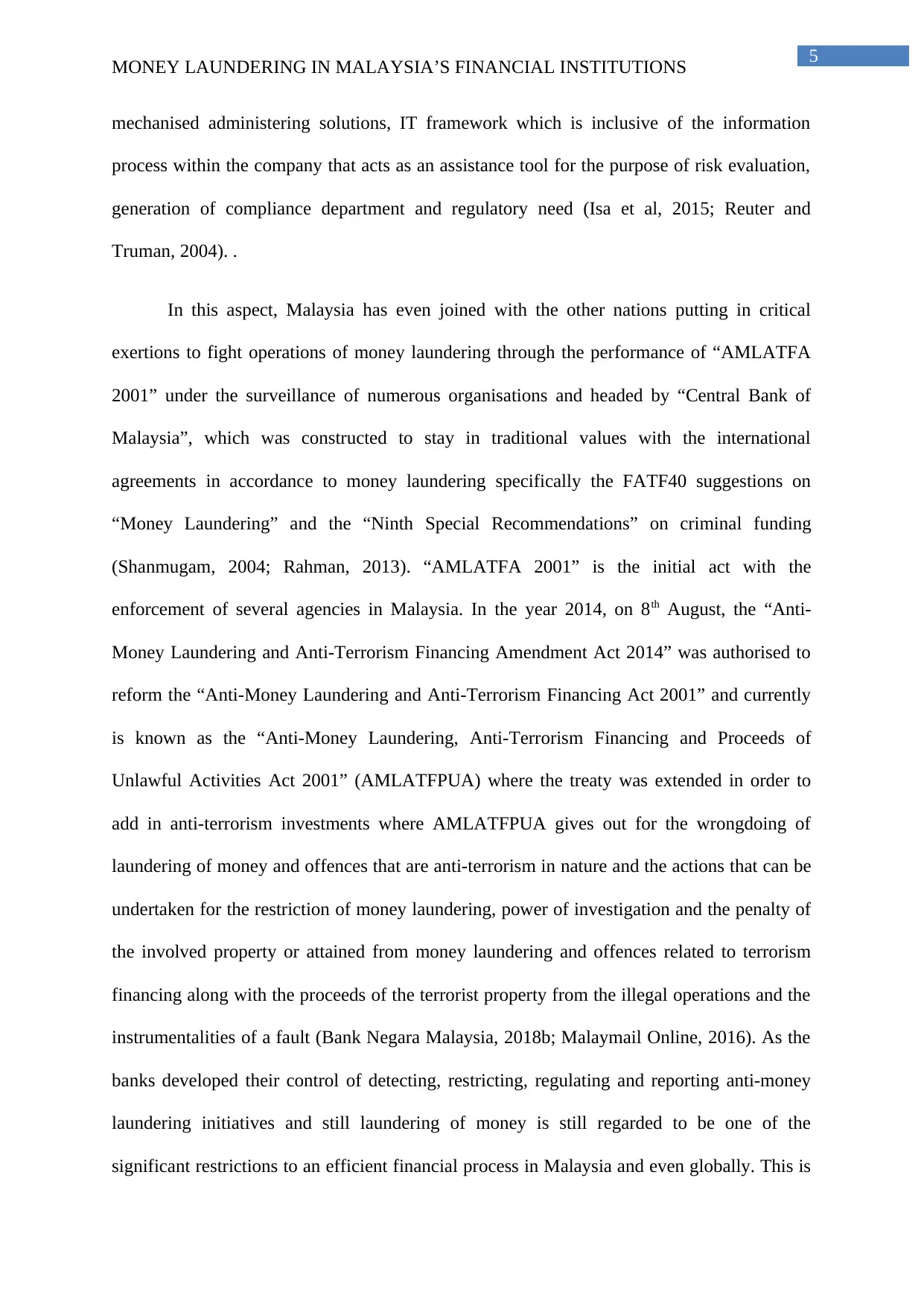
5
MONEY LAUNDERING IN MALAYSIA’S FINANCIAL INSTITUTIONS
mechanised administering solutions, IT framework which is inclusive of the information
process within the company that acts as an assistance tool for the purpose of risk evaluation,
generation of compliance department and regulatory need (Isa et al, 2015; Reuter and
Truman, 2004). .
In this aspect, Malaysia has even joined with the other nations putting in critical
exertions to fight operations of money laundering through the performance of “AMLATFA
2001” under the surveillance of numerous organisations and headed by “Central Bank of
Malaysia”, which was constructed to stay in traditional values with the international
agreements in accordance to money laundering specifically the FATF40 suggestions on
“Money Laundering” and the “Ninth Special Recommendations” on criminal funding
(Shanmugam, 2004; Rahman, 2013). “AMLATFA 2001” is the initial act with the
enforcement of several agencies in Malaysia. In the year 2014, on 8th August, the “Anti-
Money Laundering and Anti-Terrorism Financing Amendment Act 2014” was authorised to
reform the “Anti-Money Laundering and Anti-Terrorism Financing Act 2001” and currently
is known as the “Anti-Money Laundering, Anti-Terrorism Financing and Proceeds of
Unlawful Activities Act 2001” (AMLATFPUA) where the treaty was extended in order to
add in anti-terrorism investments where AMLATFPUA gives out for the wrongdoing of
laundering of money and offences that are anti-terrorism in nature and the actions that can be
undertaken for the restriction of money laundering, power of investigation and the penalty of
the involved property or attained from money laundering and offences related to terrorism
financing along with the proceeds of the terrorist property from the illegal operations and the
instrumentalities of a fault (Bank Negara Malaysia, 2018b; Malaymail Online, 2016). As the
banks developed their control of detecting, restricting, regulating and reporting anti-money
laundering initiatives and still laundering of money is still regarded to be one of the
significant restrictions to an efficient financial process in Malaysia and even globally. This is
MONEY LAUNDERING IN MALAYSIA’S FINANCIAL INSTITUTIONS
mechanised administering solutions, IT framework which is inclusive of the information
process within the company that acts as an assistance tool for the purpose of risk evaluation,
generation of compliance department and regulatory need (Isa et al, 2015; Reuter and
Truman, 2004). .
In this aspect, Malaysia has even joined with the other nations putting in critical
exertions to fight operations of money laundering through the performance of “AMLATFA
2001” under the surveillance of numerous organisations and headed by “Central Bank of
Malaysia”, which was constructed to stay in traditional values with the international
agreements in accordance to money laundering specifically the FATF40 suggestions on
“Money Laundering” and the “Ninth Special Recommendations” on criminal funding
(Shanmugam, 2004; Rahman, 2013). “AMLATFA 2001” is the initial act with the
enforcement of several agencies in Malaysia. In the year 2014, on 8th August, the “Anti-
Money Laundering and Anti-Terrorism Financing Amendment Act 2014” was authorised to
reform the “Anti-Money Laundering and Anti-Terrorism Financing Act 2001” and currently
is known as the “Anti-Money Laundering, Anti-Terrorism Financing and Proceeds of
Unlawful Activities Act 2001” (AMLATFPUA) where the treaty was extended in order to
add in anti-terrorism investments where AMLATFPUA gives out for the wrongdoing of
laundering of money and offences that are anti-terrorism in nature and the actions that can be
undertaken for the restriction of money laundering, power of investigation and the penalty of
the involved property or attained from money laundering and offences related to terrorism
financing along with the proceeds of the terrorist property from the illegal operations and the
instrumentalities of a fault (Bank Negara Malaysia, 2018b; Malaymail Online, 2016). As the
banks developed their control of detecting, restricting, regulating and reporting anti-money
laundering initiatives and still laundering of money is still regarded to be one of the
significant restrictions to an efficient financial process in Malaysia and even globally. This is
⊘ This is a preview!⊘
Do you want full access?
Subscribe today to unlock all pages.

Trusted by 1+ million students worldwide
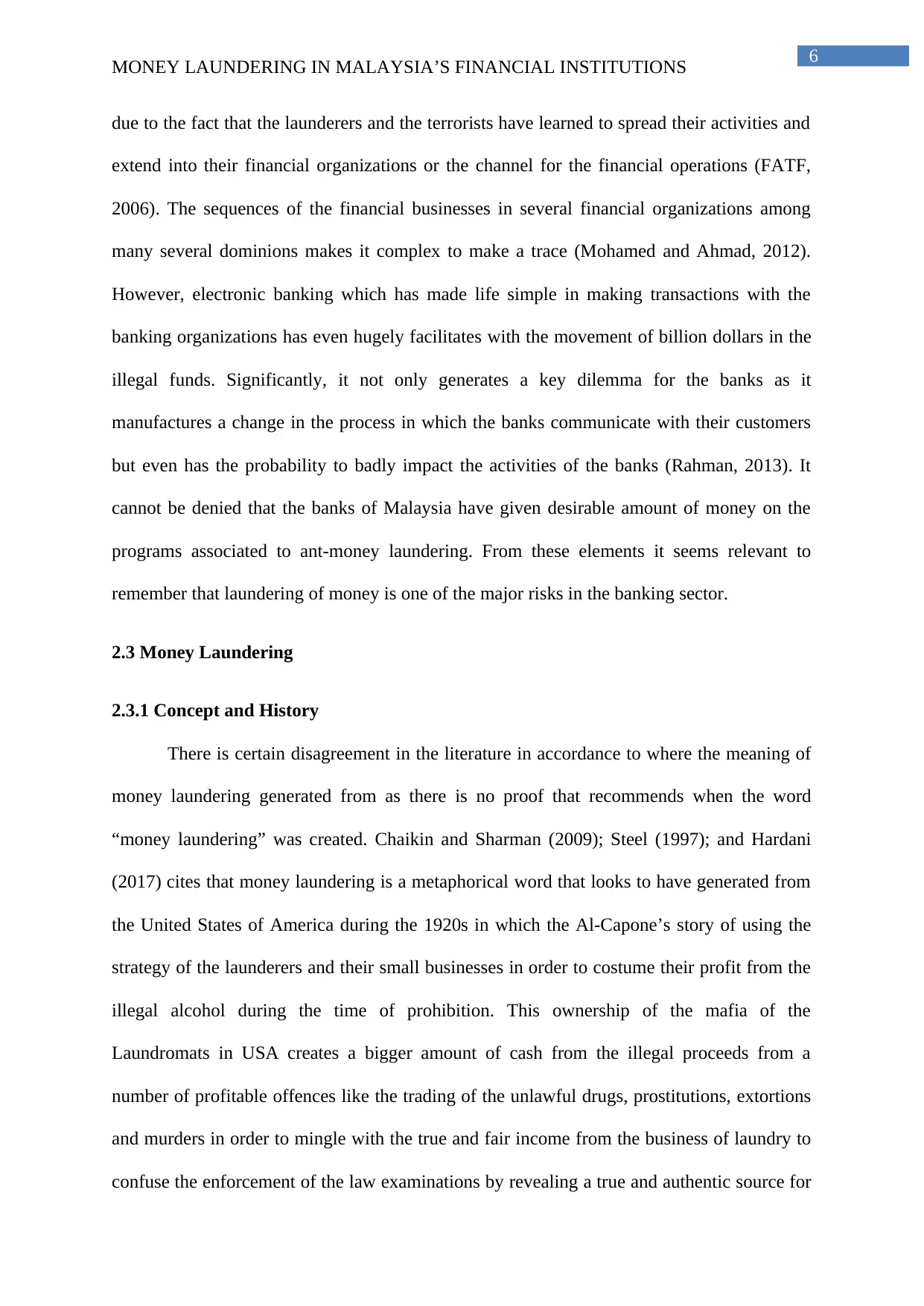
6
MONEY LAUNDERING IN MALAYSIA’S FINANCIAL INSTITUTIONS
due to the fact that the launderers and the terrorists have learned to spread their activities and
extend into their financial organizations or the channel for the financial operations (FATF,
2006). The sequences of the financial businesses in several financial organizations among
many several dominions makes it complex to make a trace (Mohamed and Ahmad, 2012).
However, electronic banking which has made life simple in making transactions with the
banking organizations has even hugely facilitates with the movement of billion dollars in the
illegal funds. Significantly, it not only generates a key dilemma for the banks as it
manufactures a change in the process in which the banks communicate with their customers
but even has the probability to badly impact the activities of the banks (Rahman, 2013). It
cannot be denied that the banks of Malaysia have given desirable amount of money on the
programs associated to ant-money laundering. From these elements it seems relevant to
remember that laundering of money is one of the major risks in the banking sector.
2.3 Money Laundering
2.3.1 Concept and History
There is certain disagreement in the literature in accordance to where the meaning of
money laundering generated from as there is no proof that recommends when the word
“money laundering” was created. Chaikin and Sharman (2009); Steel (1997); and Hardani
(2017) cites that money laundering is a metaphorical word that looks to have generated from
the United States of America during the 1920s in which the Al-Capone’s story of using the
strategy of the launderers and their small businesses in order to costume their profit from the
illegal alcohol during the time of prohibition. This ownership of the mafia of the
Laundromats in USA creates a bigger amount of cash from the illegal proceeds from a
number of profitable offences like the trading of the unlawful drugs, prostitutions, extortions
and murders in order to mingle with the true and fair income from the business of laundry to
confuse the enforcement of the law examinations by revealing a true and authentic source for
MONEY LAUNDERING IN MALAYSIA’S FINANCIAL INSTITUTIONS
due to the fact that the launderers and the terrorists have learned to spread their activities and
extend into their financial organizations or the channel for the financial operations (FATF,
2006). The sequences of the financial businesses in several financial organizations among
many several dominions makes it complex to make a trace (Mohamed and Ahmad, 2012).
However, electronic banking which has made life simple in making transactions with the
banking organizations has even hugely facilitates with the movement of billion dollars in the
illegal funds. Significantly, it not only generates a key dilemma for the banks as it
manufactures a change in the process in which the banks communicate with their customers
but even has the probability to badly impact the activities of the banks (Rahman, 2013). It
cannot be denied that the banks of Malaysia have given desirable amount of money on the
programs associated to ant-money laundering. From these elements it seems relevant to
remember that laundering of money is one of the major risks in the banking sector.
2.3 Money Laundering
2.3.1 Concept and History
There is certain disagreement in the literature in accordance to where the meaning of
money laundering generated from as there is no proof that recommends when the word
“money laundering” was created. Chaikin and Sharman (2009); Steel (1997); and Hardani
(2017) cites that money laundering is a metaphorical word that looks to have generated from
the United States of America during the 1920s in which the Al-Capone’s story of using the
strategy of the launderers and their small businesses in order to costume their profit from the
illegal alcohol during the time of prohibition. This ownership of the mafia of the
Laundromats in USA creates a bigger amount of cash from the illegal proceeds from a
number of profitable offences like the trading of the unlawful drugs, prostitutions, extortions
and murders in order to mingle with the true and fair income from the business of laundry to
confuse the enforcement of the law examinations by revealing a true and authentic source for
Paraphrase This Document
Need a fresh take? Get an instant paraphrase of this document with our AI Paraphraser
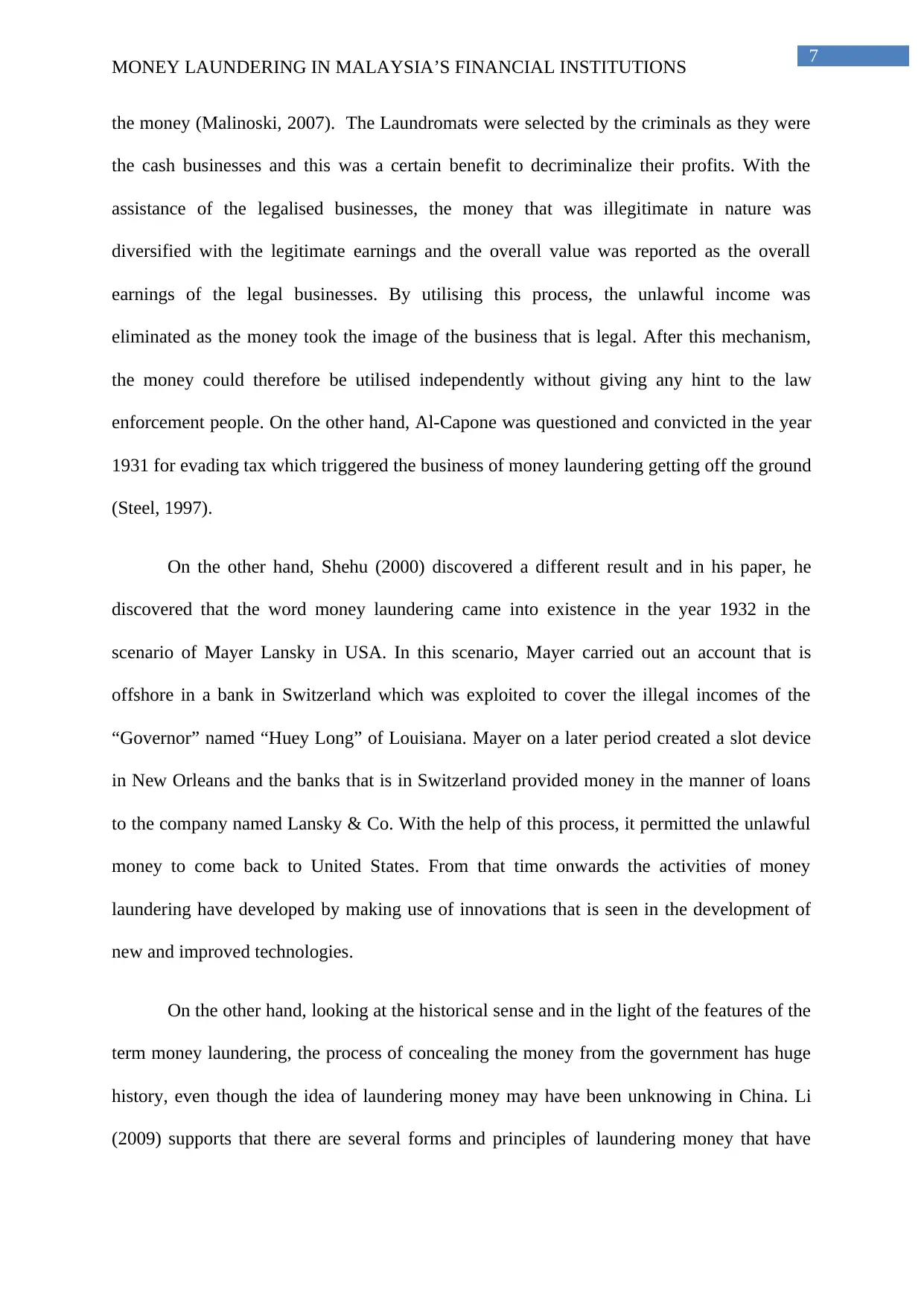
7
MONEY LAUNDERING IN MALAYSIA’S FINANCIAL INSTITUTIONS
the money (Malinoski, 2007). The Laundromats were selected by the criminals as they were
the cash businesses and this was a certain benefit to decriminalize their profits. With the
assistance of the legalised businesses, the money that was illegitimate in nature was
diversified with the legitimate earnings and the overall value was reported as the overall
earnings of the legal businesses. By utilising this process, the unlawful income was
eliminated as the money took the image of the business that is legal. After this mechanism,
the money could therefore be utilised independently without giving any hint to the law
enforcement people. On the other hand, Al-Capone was questioned and convicted in the year
1931 for evading tax which triggered the business of money laundering getting off the ground
(Steel, 1997).
On the other hand, Shehu (2000) discovered a different result and in his paper, he
discovered that the word money laundering came into existence in the year 1932 in the
scenario of Mayer Lansky in USA. In this scenario, Mayer carried out an account that is
offshore in a bank in Switzerland which was exploited to cover the illegal incomes of the
“Governor” named “Huey Long” of Louisiana. Mayer on a later period created a slot device
in New Orleans and the banks that is in Switzerland provided money in the manner of loans
to the company named Lansky & Co. With the help of this process, it permitted the unlawful
money to come back to United States. From that time onwards the activities of money
laundering have developed by making use of innovations that is seen in the development of
new and improved technologies.
On the other hand, looking at the historical sense and in the light of the features of the
term money laundering, the process of concealing the money from the government has huge
history, even though the idea of laundering money may have been unknowing in China. Li
(2009) supports that there are several forms and principles of laundering money that have
MONEY LAUNDERING IN MALAYSIA’S FINANCIAL INSTITUTIONS
the money (Malinoski, 2007). The Laundromats were selected by the criminals as they were
the cash businesses and this was a certain benefit to decriminalize their profits. With the
assistance of the legalised businesses, the money that was illegitimate in nature was
diversified with the legitimate earnings and the overall value was reported as the overall
earnings of the legal businesses. By utilising this process, the unlawful income was
eliminated as the money took the image of the business that is legal. After this mechanism,
the money could therefore be utilised independently without giving any hint to the law
enforcement people. On the other hand, Al-Capone was questioned and convicted in the year
1931 for evading tax which triggered the business of money laundering getting off the ground
(Steel, 1997).
On the other hand, Shehu (2000) discovered a different result and in his paper, he
discovered that the word money laundering came into existence in the year 1932 in the
scenario of Mayer Lansky in USA. In this scenario, Mayer carried out an account that is
offshore in a bank in Switzerland which was exploited to cover the illegal incomes of the
“Governor” named “Huey Long” of Louisiana. Mayer on a later period created a slot device
in New Orleans and the banks that is in Switzerland provided money in the manner of loans
to the company named Lansky & Co. With the help of this process, it permitted the unlawful
money to come back to United States. From that time onwards the activities of money
laundering have developed by making use of innovations that is seen in the development of
new and improved technologies.
On the other hand, looking at the historical sense and in the light of the features of the
term money laundering, the process of concealing the money from the government has huge
history, even though the idea of laundering money may have been unknowing in China. Li
(2009) supports that there are several forms and principles of laundering money that have
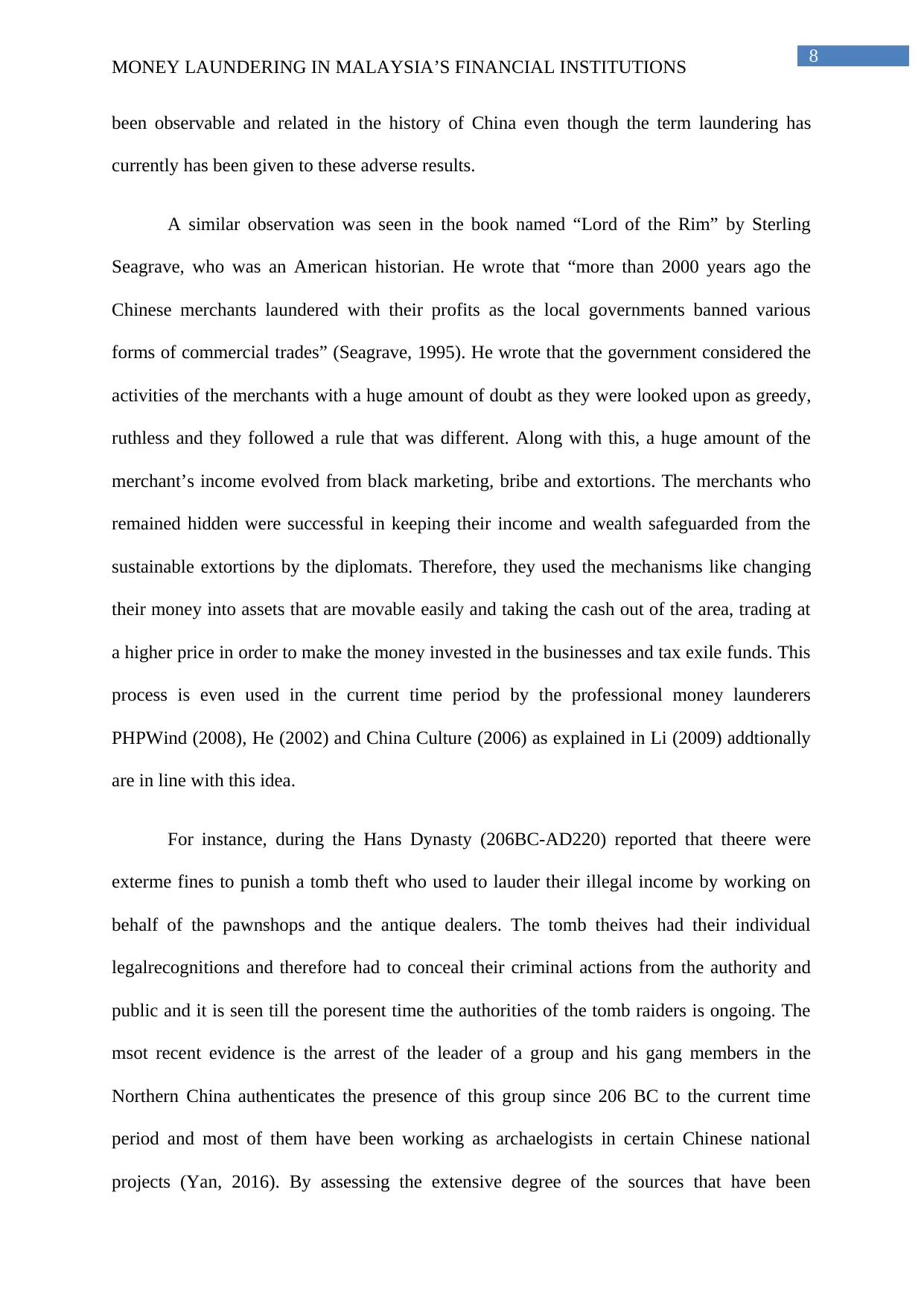
8
MONEY LAUNDERING IN MALAYSIA’S FINANCIAL INSTITUTIONS
been observable and related in the history of China even though the term laundering has
currently has been given to these adverse results.
A similar observation was seen in the book named “Lord of the Rim” by Sterling
Seagrave, who was an American historian. He wrote that “more than 2000 years ago the
Chinese merchants laundered with their profits as the local governments banned various
forms of commercial trades” (Seagrave, 1995). He wrote that the government considered the
activities of the merchants with a huge amount of doubt as they were looked upon as greedy,
ruthless and they followed a rule that was different. Along with this, a huge amount of the
merchant’s income evolved from black marketing, bribe and extortions. The merchants who
remained hidden were successful in keeping their income and wealth safeguarded from the
sustainable extortions by the diplomats. Therefore, they used the mechanisms like changing
their money into assets that are movable easily and taking the cash out of the area, trading at
a higher price in order to make the money invested in the businesses and tax exile funds. This
process is even used in the current time period by the professional money launderers
PHPWind (2008), He (2002) and China Culture (2006) as explained in Li (2009) addtionally
are in line with this idea.
For instance, during the Hans Dynasty (206BC-AD220) reported that theere were
exterme fines to punish a tomb theft who used to lauder their illegal income by working on
behalf of the pawnshops and the antique dealers. The tomb theives had their individual
legalrecognitions and therefore had to conceal their criminal actions from the authority and
public and it is seen till the poresent time the authorities of the tomb raiders is ongoing. The
msot recent evidence is the arrest of the leader of a group and his gang members in the
Northern China authenticates the presence of this group since 206 BC to the current time
period and most of them have been working as archaelogists in certain Chinese national
projects (Yan, 2016). By assessing the extensive degree of the sources that have been
MONEY LAUNDERING IN MALAYSIA’S FINANCIAL INSTITUTIONS
been observable and related in the history of China even though the term laundering has
currently has been given to these adverse results.
A similar observation was seen in the book named “Lord of the Rim” by Sterling
Seagrave, who was an American historian. He wrote that “more than 2000 years ago the
Chinese merchants laundered with their profits as the local governments banned various
forms of commercial trades” (Seagrave, 1995). He wrote that the government considered the
activities of the merchants with a huge amount of doubt as they were looked upon as greedy,
ruthless and they followed a rule that was different. Along with this, a huge amount of the
merchant’s income evolved from black marketing, bribe and extortions. The merchants who
remained hidden were successful in keeping their income and wealth safeguarded from the
sustainable extortions by the diplomats. Therefore, they used the mechanisms like changing
their money into assets that are movable easily and taking the cash out of the area, trading at
a higher price in order to make the money invested in the businesses and tax exile funds. This
process is even used in the current time period by the professional money launderers
PHPWind (2008), He (2002) and China Culture (2006) as explained in Li (2009) addtionally
are in line with this idea.
For instance, during the Hans Dynasty (206BC-AD220) reported that theere were
exterme fines to punish a tomb theft who used to lauder their illegal income by working on
behalf of the pawnshops and the antique dealers. The tomb theives had their individual
legalrecognitions and therefore had to conceal their criminal actions from the authority and
public and it is seen till the poresent time the authorities of the tomb raiders is ongoing. The
msot recent evidence is the arrest of the leader of a group and his gang members in the
Northern China authenticates the presence of this group since 206 BC to the current time
period and most of them have been working as archaelogists in certain Chinese national
projects (Yan, 2016). By assessing the extensive degree of the sources that have been
⊘ This is a preview!⊘
Do you want full access?
Subscribe today to unlock all pages.

Trusted by 1+ million students worldwide
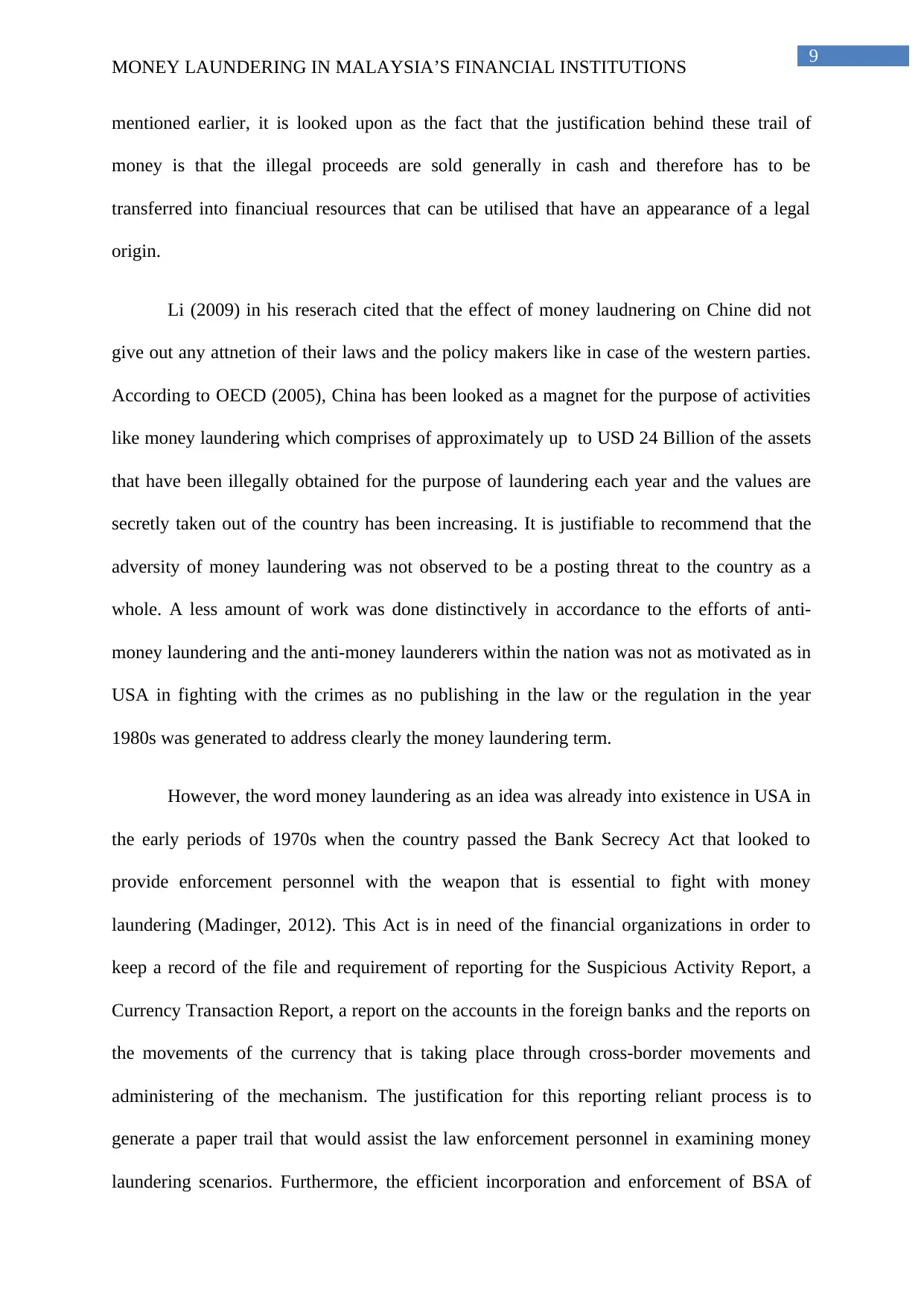
9
MONEY LAUNDERING IN MALAYSIA’S FINANCIAL INSTITUTIONS
mentioned earlier, it is looked upon as the fact that the justification behind these trail of
money is that the illegal proceeds are sold generally in cash and therefore has to be
transferred into financiual resources that can be utilised that have an appearance of a legal
origin.
Li (2009) in his reserach cited that the effect of money laudnering on Chine did not
give out any attnetion of their laws and the policy makers like in case of the western parties.
According to OECD (2005), China has been looked as a magnet for the purpose of activities
like money laundering which comprises of approximately up to USD 24 Billion of the assets
that have been illegally obtained for the purpose of laundering each year and the values are
secretly taken out of the country has been increasing. It is justifiable to recommend that the
adversity of money laundering was not observed to be a posting threat to the country as a
whole. A less amount of work was done distinctively in accordance to the efforts of anti-
money laundering and the anti-money launderers within the nation was not as motivated as in
USA in fighting with the crimes as no publishing in the law or the regulation in the year
1980s was generated to address clearly the money laundering term.
However, the word money laundering as an idea was already into existence in USA in
the early periods of 1970s when the country passed the Bank Secrecy Act that looked to
provide enforcement personnel with the weapon that is essential to fight with money
laundering (Madinger, 2012). This Act is in need of the financial organizations in order to
keep a record of the file and requirement of reporting for the Suspicious Activity Report, a
Currency Transaction Report, a report on the accounts in the foreign banks and the reports on
the movements of the currency that is taking place through cross-border movements and
administering of the mechanism. The justification for this reporting reliant process is to
generate a paper trail that would assist the law enforcement personnel in examining money
laundering scenarios. Furthermore, the efficient incorporation and enforcement of BSA of
MONEY LAUNDERING IN MALAYSIA’S FINANCIAL INSTITUTIONS
mentioned earlier, it is looked upon as the fact that the justification behind these trail of
money is that the illegal proceeds are sold generally in cash and therefore has to be
transferred into financiual resources that can be utilised that have an appearance of a legal
origin.
Li (2009) in his reserach cited that the effect of money laudnering on Chine did not
give out any attnetion of their laws and the policy makers like in case of the western parties.
According to OECD (2005), China has been looked as a magnet for the purpose of activities
like money laundering which comprises of approximately up to USD 24 Billion of the assets
that have been illegally obtained for the purpose of laundering each year and the values are
secretly taken out of the country has been increasing. It is justifiable to recommend that the
adversity of money laundering was not observed to be a posting threat to the country as a
whole. A less amount of work was done distinctively in accordance to the efforts of anti-
money laundering and the anti-money launderers within the nation was not as motivated as in
USA in fighting with the crimes as no publishing in the law or the regulation in the year
1980s was generated to address clearly the money laundering term.
However, the word money laundering as an idea was already into existence in USA in
the early periods of 1970s when the country passed the Bank Secrecy Act that looked to
provide enforcement personnel with the weapon that is essential to fight with money
laundering (Madinger, 2012). This Act is in need of the financial organizations in order to
keep a record of the file and requirement of reporting for the Suspicious Activity Report, a
Currency Transaction Report, a report on the accounts in the foreign banks and the reports on
the movements of the currency that is taking place through cross-border movements and
administering of the mechanism. The justification for this reporting reliant process is to
generate a paper trail that would assist the law enforcement personnel in examining money
laundering scenarios. Furthermore, the efficient incorporation and enforcement of BSA of
Paraphrase This Document
Need a fresh take? Get an instant paraphrase of this document with our AI Paraphraser
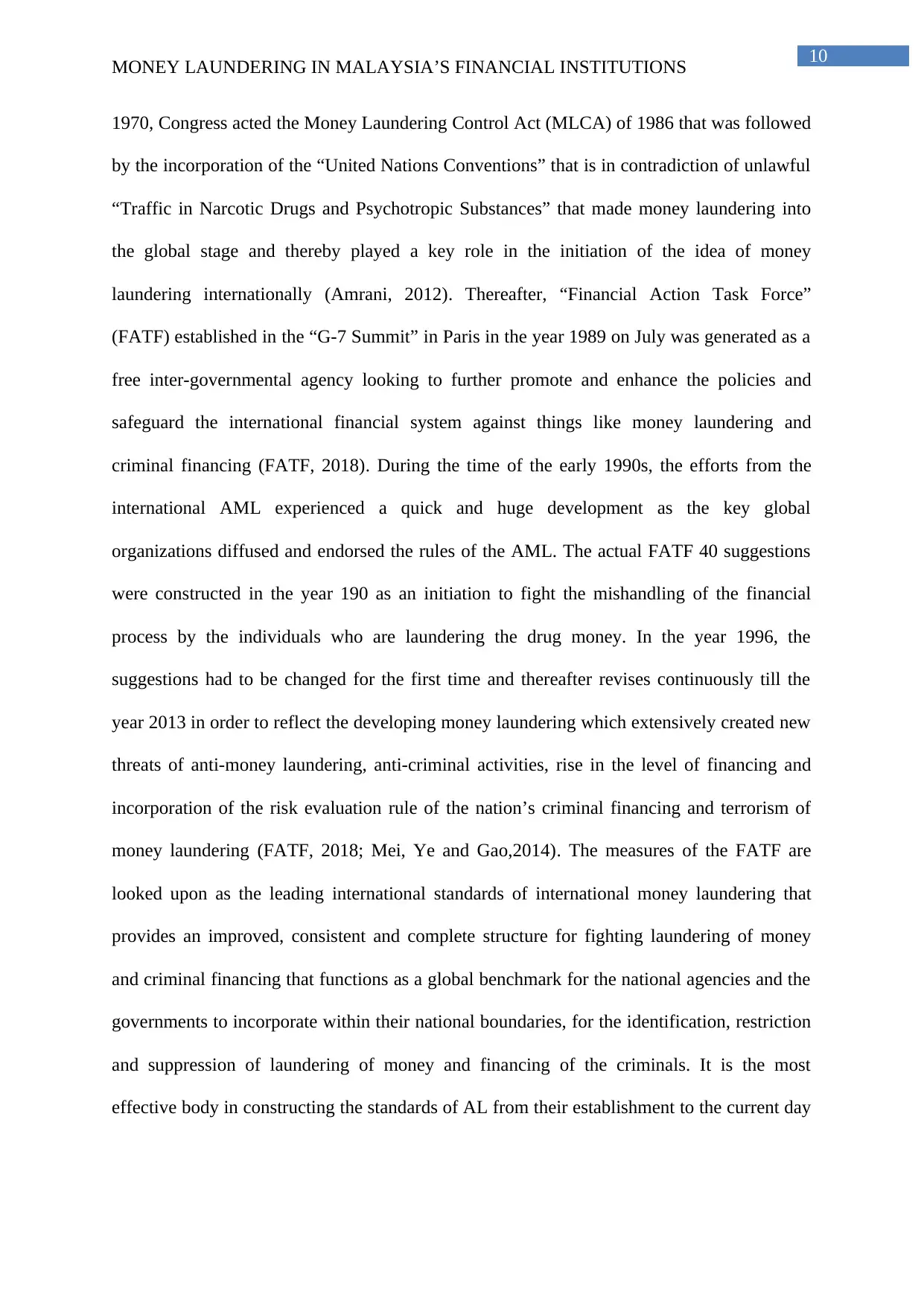
10
MONEY LAUNDERING IN MALAYSIA’S FINANCIAL INSTITUTIONS
1970, Congress acted the Money Laundering Control Act (MLCA) of 1986 that was followed
by the incorporation of the “United Nations Conventions” that is in contradiction of unlawful
“Traffic in Narcotic Drugs and Psychotropic Substances” that made money laundering into
the global stage and thereby played a key role in the initiation of the idea of money
laundering internationally (Amrani, 2012). Thereafter, “Financial Action Task Force”
(FATF) established in the “G-7 Summit” in Paris in the year 1989 on July was generated as a
free inter-governmental agency looking to further promote and enhance the policies and
safeguard the international financial system against things like money laundering and
criminal financing (FATF, 2018). During the time of the early 1990s, the efforts from the
international AML experienced a quick and huge development as the key global
organizations diffused and endorsed the rules of the AML. The actual FATF 40 suggestions
were constructed in the year 190 as an initiation to fight the mishandling of the financial
process by the individuals who are laundering the drug money. In the year 1996, the
suggestions had to be changed for the first time and thereafter revises continuously till the
year 2013 in order to reflect the developing money laundering which extensively created new
threats of anti-money laundering, anti-criminal activities, rise in the level of financing and
incorporation of the risk evaluation rule of the nation’s criminal financing and terrorism of
money laundering (FATF, 2018; Mei, Ye and Gao,2014). The measures of the FATF are
looked upon as the leading international standards of international money laundering that
provides an improved, consistent and complete structure for fighting laundering of money
and criminal financing that functions as a global benchmark for the national agencies and the
governments to incorporate within their national boundaries, for the identification, restriction
and suppression of laundering of money and financing of the criminals. It is the most
effective body in constructing the standards of AL from their establishment to the current day
MONEY LAUNDERING IN MALAYSIA’S FINANCIAL INSTITUTIONS
1970, Congress acted the Money Laundering Control Act (MLCA) of 1986 that was followed
by the incorporation of the “United Nations Conventions” that is in contradiction of unlawful
“Traffic in Narcotic Drugs and Psychotropic Substances” that made money laundering into
the global stage and thereby played a key role in the initiation of the idea of money
laundering internationally (Amrani, 2012). Thereafter, “Financial Action Task Force”
(FATF) established in the “G-7 Summit” in Paris in the year 1989 on July was generated as a
free inter-governmental agency looking to further promote and enhance the policies and
safeguard the international financial system against things like money laundering and
criminal financing (FATF, 2018). During the time of the early 1990s, the efforts from the
international AML experienced a quick and huge development as the key global
organizations diffused and endorsed the rules of the AML. The actual FATF 40 suggestions
were constructed in the year 190 as an initiation to fight the mishandling of the financial
process by the individuals who are laundering the drug money. In the year 1996, the
suggestions had to be changed for the first time and thereafter revises continuously till the
year 2013 in order to reflect the developing money laundering which extensively created new
threats of anti-money laundering, anti-criminal activities, rise in the level of financing and
incorporation of the risk evaluation rule of the nation’s criminal financing and terrorism of
money laundering (FATF, 2018; Mei, Ye and Gao,2014). The measures of the FATF are
looked upon as the leading international standards of international money laundering that
provides an improved, consistent and complete structure for fighting laundering of money
and criminal financing that functions as a global benchmark for the national agencies and the
governments to incorporate within their national boundaries, for the identification, restriction
and suppression of laundering of money and financing of the criminals. It is the most
effective body in constructing the standards of AL from their establishment to the current day
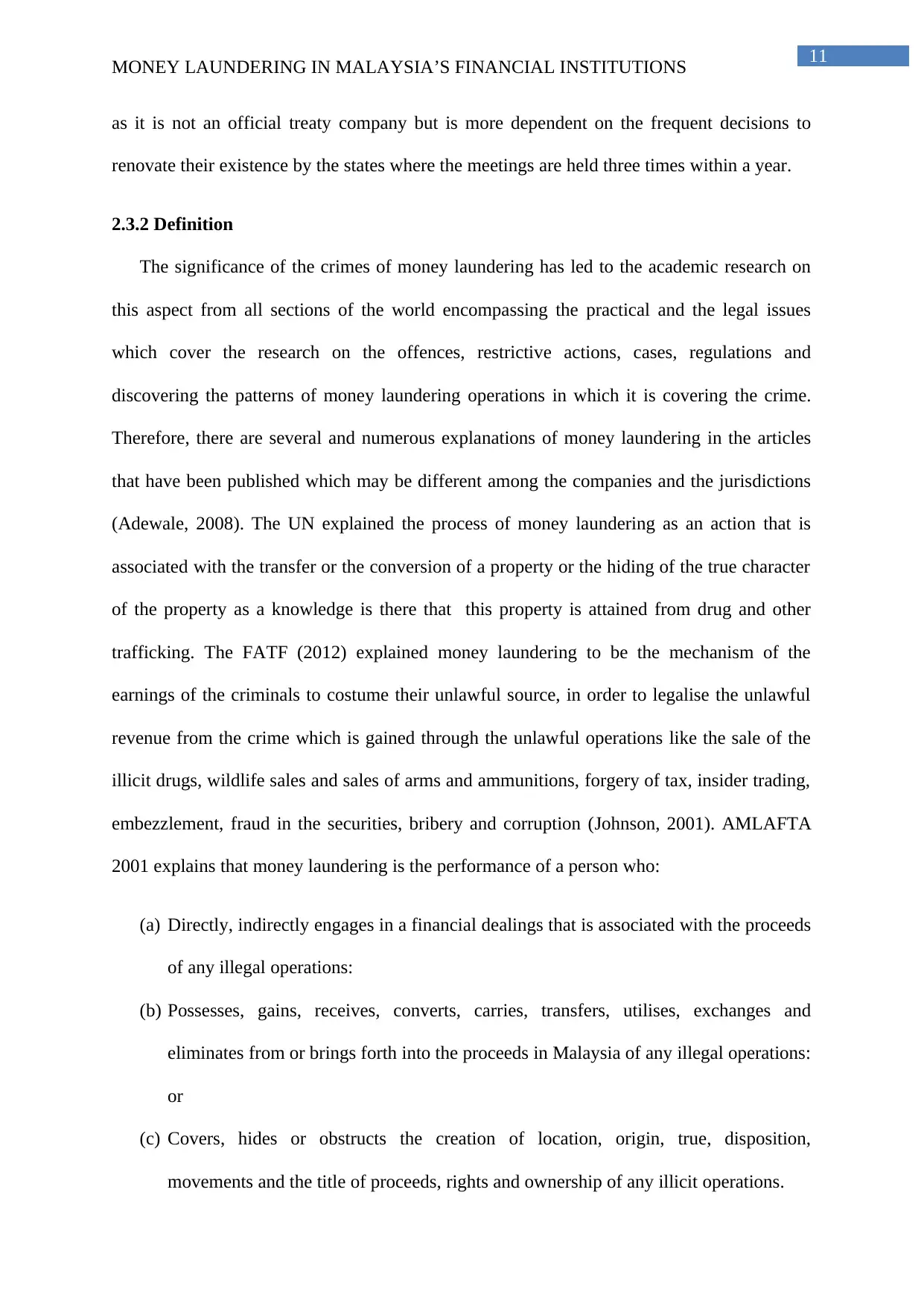
11
MONEY LAUNDERING IN MALAYSIA’S FINANCIAL INSTITUTIONS
as it is not an official treaty company but is more dependent on the frequent decisions to
renovate their existence by the states where the meetings are held three times within a year.
2.3.2 Definition
The significance of the crimes of money laundering has led to the academic research on
this aspect from all sections of the world encompassing the practical and the legal issues
which cover the research on the offences, restrictive actions, cases, regulations and
discovering the patterns of money laundering operations in which it is covering the crime.
Therefore, there are several and numerous explanations of money laundering in the articles
that have been published which may be different among the companies and the jurisdictions
(Adewale, 2008). The UN explained the process of money laundering as an action that is
associated with the transfer or the conversion of a property or the hiding of the true character
of the property as a knowledge is there that this property is attained from drug and other
trafficking. The FATF (2012) explained money laundering to be the mechanism of the
earnings of the criminals to costume their unlawful source, in order to legalise the unlawful
revenue from the crime which is gained through the unlawful operations like the sale of the
illicit drugs, wildlife sales and sales of arms and ammunitions, forgery of tax, insider trading,
embezzlement, fraud in the securities, bribery and corruption (Johnson, 2001). AMLAFTA
2001 explains that money laundering is the performance of a person who:
(a) Directly, indirectly engages in a financial dealings that is associated with the proceeds
of any illegal operations:
(b) Possesses, gains, receives, converts, carries, transfers, utilises, exchanges and
eliminates from or brings forth into the proceeds in Malaysia of any illegal operations:
or
(c) Covers, hides or obstructs the creation of location, origin, true, disposition,
movements and the title of proceeds, rights and ownership of any illicit operations.
MONEY LAUNDERING IN MALAYSIA’S FINANCIAL INSTITUTIONS
as it is not an official treaty company but is more dependent on the frequent decisions to
renovate their existence by the states where the meetings are held three times within a year.
2.3.2 Definition
The significance of the crimes of money laundering has led to the academic research on
this aspect from all sections of the world encompassing the practical and the legal issues
which cover the research on the offences, restrictive actions, cases, regulations and
discovering the patterns of money laundering operations in which it is covering the crime.
Therefore, there are several and numerous explanations of money laundering in the articles
that have been published which may be different among the companies and the jurisdictions
(Adewale, 2008). The UN explained the process of money laundering as an action that is
associated with the transfer or the conversion of a property or the hiding of the true character
of the property as a knowledge is there that this property is attained from drug and other
trafficking. The FATF (2012) explained money laundering to be the mechanism of the
earnings of the criminals to costume their unlawful source, in order to legalise the unlawful
revenue from the crime which is gained through the unlawful operations like the sale of the
illicit drugs, wildlife sales and sales of arms and ammunitions, forgery of tax, insider trading,
embezzlement, fraud in the securities, bribery and corruption (Johnson, 2001). AMLAFTA
2001 explains that money laundering is the performance of a person who:
(a) Directly, indirectly engages in a financial dealings that is associated with the proceeds
of any illegal operations:
(b) Possesses, gains, receives, converts, carries, transfers, utilises, exchanges and
eliminates from or brings forth into the proceeds in Malaysia of any illegal operations:
or
(c) Covers, hides or obstructs the creation of location, origin, true, disposition,
movements and the title of proceeds, rights and ownership of any illicit operations.
⊘ This is a preview!⊘
Do you want full access?
Subscribe today to unlock all pages.

Trusted by 1+ million students worldwide
1 out of 34
Related Documents
Your All-in-One AI-Powered Toolkit for Academic Success.
+13062052269
info@desklib.com
Available 24*7 on WhatsApp / Email
![[object Object]](/_next/static/media/star-bottom.7253800d.svg)
Unlock your academic potential
Copyright © 2020–2025 A2Z Services. All Rights Reserved. Developed and managed by ZUCOL.





